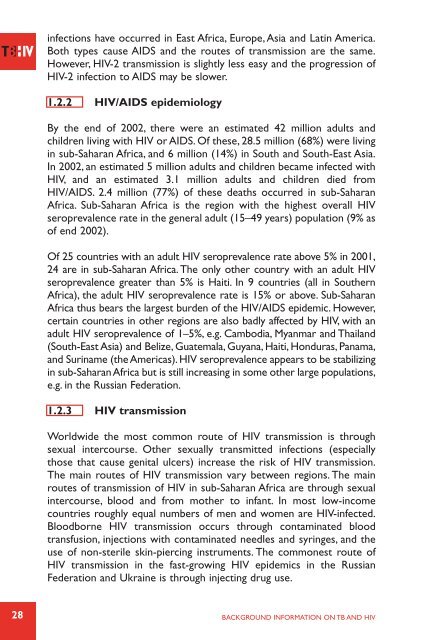TB/HIV: a clinical manual - libdoc.who.int - World Health Organization
TB/HIV: a clinical manual - libdoc.who.int - World Health Organization
TB/HIV: a clinical manual - libdoc.who.int - World Health Organization
You also want an ePaper? Increase the reach of your titles
YUMPU automatically turns print PDFs into web optimized ePapers that Google loves.
infections have occurred in East Africa, Europe, Asia and Latin America.Both types cause AIDS and the routes of transmission are the same.However, <strong>HIV</strong>-2 transmission is slightly less easy and the progression of<strong>HIV</strong>-2 infection to AIDS may be slower.1.2.2 <strong>HIV</strong>/AIDS epidemiologyBy the end of 2002, there were an estimated 42 million adults andchildren living with <strong>HIV</strong> or AIDS. Of these, 28.5 million (68%) were livingin sub-Saharan Africa, and 6 million (14%) in South and South-East Asia.In 2002, an estimated 5 million adults and children became infected with<strong>HIV</strong>, and an estimated 3.1 million adults and children died from<strong>HIV</strong>/AIDS. 2.4 million (77%) of these deaths occurred in sub-SaharanAfrica. Sub-Saharan Africa is the region with the highest overall <strong>HIV</strong>seroprevalence rate in the general adult (15–49 years) population (9% asof end 2002).Of 25 countries with an adult <strong>HIV</strong> seroprevalence rate above 5% in 2001,24 are in sub-Saharan Africa. The only other country with an adult <strong>HIV</strong>seroprevalence greater than 5% is Haiti. In 9 countries (all in SouthernAfrica), the adult <strong>HIV</strong> seroprevalence rate is 15% or above. Sub-SaharanAfrica thus bears the largest burden of the <strong>HIV</strong>/AIDS epidemic. However,certain countries in other regions are also badly affected by <strong>HIV</strong>, with anadult <strong>HIV</strong> seroprevalence of 1–5%, e.g. Cambodia, Myanmar and Thailand(South-East Asia) and Belize, Guatemala, Guyana, Haiti, Honduras, Panama,and Suriname (the Americas). <strong>HIV</strong> seroprevalence appears to be stabilizingin sub-Saharan Africa but is still increasing in some other large populations,e.g. in the Russian Federation.1.2.3 <strong>HIV</strong> transmission<strong>World</strong>wide the most common route of <strong>HIV</strong> transmission is throughsexual <strong>int</strong>ercourse. Other sexually transmitted infections (especiallythose that cause genital ulcers) increase the risk of <strong>HIV</strong> transmission.The main routes of <strong>HIV</strong> transmission vary between regions. The mainroutes of transmission of <strong>HIV</strong> in sub-Saharan Africa are through sexual<strong>int</strong>ercourse, blood and from mother to infant. In most low-incomecountries roughly equal numbers of men and women are <strong>HIV</strong>-infected.Bloodborne <strong>HIV</strong> transmission occurs through contaminated bloodtransfusion, injections with contaminated needles and syringes, and theuse of non-sterile skin-piercing instruments. The commonest route of<strong>HIV</strong> transmission in the fast-growing <strong>HIV</strong> epidemics in the RussianFederation and Ukraine is through injecting drug use.28 BACKGROUND INFORMATION ON <strong>TB</strong> AND <strong>HIV</strong>
















